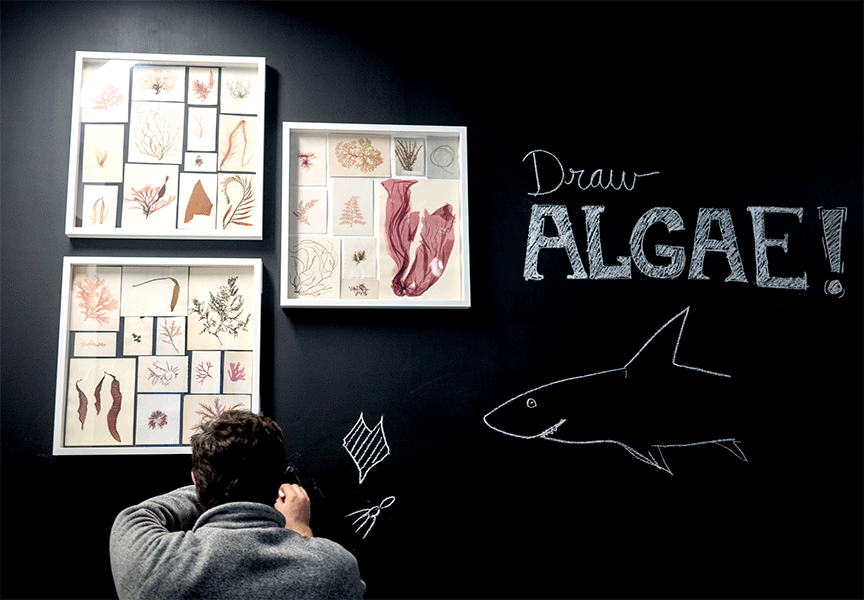The Algae Society: Bio Art Design Lab inaugural exhibition, co-curated by Gene Felice, José Carlos Espinel, and Jennifer Parker, celebrates algae as an unsung hero of the planet and invites guests to learn about how algae contribute to the health and stability of our planet and the effects global warming is having on these valuable creatures by interacting with its several components. See the projects link page to learn about each of the works included in the exhibit.






Included in the exhibit is the “Cabinet of Curiosity” and the Algae Society library nook which includes peephole visual representation of the effects that ocean acidification is having on the different algae species, the Back to the Anemone video game, algae growing in the desert, and sonic art with visualizations pulsating and breathing with algae.



Botanist Anna Atkins developed British Algae: Cyanotype Impressions line the windows next to a video inviting visitors into a scientist’s lab to learn about the tools and techniques she uses to conduct marine science research.

The Oceanic Scales exhibit explore their role in maintaining a stable ocean ecology through a multi-sensory, interactive art and science puzzle inspired by the microorganisms of the sea. The hope is to encourage change toward sustainable living practices by engaging the public to reflect on and perhaps better understand how humans impact the environment at local and global scales.





Visitors to Oceanic Scales turn the different knobs to see how nutrients, PH/acidity, and temperature affect the phytoplankton as noted by the changing in sound, light and video projections along the windows.

Historical dried seaweed pressings loaned by Cheadle Center for Biodiversity and Ecological Restoration (CCBER) collection at the University of California Santa Barbara, adorn the Algae Society chalk wall.
Fun fact: chalk layers of soft limestone are formed from the remains of coccolithophores, a type of marine phytoplankton with an intricate exoskeleton.


The Algae Society: Bio Art Design Lab celebrates algae as an unsung hero of the planet and invites guests to learn about how algae contributes to the health and stability of our planet and the effects global warming is having on these valuable creatures by interacting with its several components. See the projects link page to learn about each of the works included in the exhibit.




Included in the exhibit is the “Cabinet of Curiosity” and the Algae Society library nook which includes peephole visual representation of the effects that ocean acidification is having on the different algae species, the Back to the Anemone video game, algae growing in the desert, and sonic art with visualizations pulsating and breathing with algae.



Botanist Anna Atkins developed British Algae: Cyanotype Impressions line the windows next to a video inviting visitors into a scientist’s lab to learn about the tools and techniques she uses to conduct marine science research.

The Oceanic Scales exhibit explore their role in maintaining a stable ocean ecology through a multi-sensory, interactive art and science puzzle inspired by the microorganisms of the sea. The hope is to encourage change toward sustainable living practices by engaging the public to reflect on and perhaps better understand how humans impact the environment at local and global scales.





Visitors to Oceanic Scales turn the different knobs to see how nutrients, PH/acidity, and temperature affect the phytoplankton as noted by the changing in sound, light and video projections along the windows.

Historical dried seaweed pressings loaned by Cheadle Center for Biodiversity and Ecological Restoration (CCBER) collection at the University of California Santa Barbara, adorn the Algae Society chalk wall.
Fun fact: chalk layers of soft limestone are formed from the remains of coccolithophores, a type of marine phytoplankton with an intricate exoskeleton.
